Johann Joseph Fux published his treatise on musical counterpoint Gradus ad Parnassum ["Steps to the Summit of Mt Parnassus"] in 1725, in Latin. Filled with exercises which are presented in a graded, systematic method, it rapidly became one of the most widely used books to learn how to compose counterpoint, used and cited by almost all of the most famous European composers of the "common-practice" era from Haydn to Brahms and Bruckner. It is still to this day one of the most widely studied books on counterpoint, however, most readers use the modern English translation by Alfred Mann published in 1965, which is considerably abridged from Fux's original text, beginning with the dialog which opens Book 2, and omitting almost all of Book 1 with the exception of a small section from the last chapter (the 23rd) describing similar, contrary, and oblique motion. The first 22 chapters of Book 1 give a detailed analysis of the mathematical procedures used for calculating with ratios (chapters 1 to 14) and a systematic description of the intervals of the diatonic scale as 5-limit just-intonation ratios. I present my English translation of these sections here for the benefit of microtonal musicians who want to study Fux's method using the tuning he intended.
[Title page] The steps to Parnassus or manual guidance to regular musical composition a new and sure method, not yet before published in the same exact order: Developed by Joanne Joseph Fux, Sacred Caesarea and the Royal Catholic Majesty of Charles VI. Emperor of the Romans supreme commander of the choir.
[dedication pages] Most August, Invincible, and the most powerful prince Charles VI. Romance to the emperor Germany, Spain, Hungary, Bohemia to the king Archduke of Austria, &c. &c. To the Most Merciful Lord Augustus Caesar
If the rivers reflect their course to the ocean, whence they take their origin: if the earth, moistened with the morning dew, sends back the same moisture, as if in gratitude, to the ether;
Where else does this little book turn, if not to YOU AUGUSTE? For it is yours by right of the Lord; because the delivery of the client. It is originally yours; because under the auspices of your glorious Ancestors my music took its beginning and continued to grow. Thou, most exalted Monarch, hast added mind: Thou hast supplied the cost: with the most gracious gesture of Thy Benevolence it comes to light. Whatever profit, therefore, the young man, eager for profit, takes from thence, must be reported entirely to YOUR MAJESTY in his receipts. For this reason do not deign to look with kind eyes on what is all part of yours: and whose previous labors of life you confirmed with such a gracious consent (how much effort it is to satisfy your exquisite and selected taste) the last of the same, like a swan's song, you with the same kindness I do not at all doubt that it will be complex. Relying on this hope, I die at my sacred feet
SACRED CAESAR ROYAL CATHOLIC YOUR MAJESTY The lowest customer Joannes Josephus Fux, Styrus.
[chapters 1 to 14 explain ratio arithmetic; skipped here for now]
[p 21]
CHAPTER 15
The Octave
The octave [8th] is so called because it consists of eight sounds; it is the greatest of all simple intervals; in Greek it is called _Diapason_, which word signifies a universe, because the Octave includes all possible intervals; actually simple, but potentially compound. But with the Octave, since the content
[p 22]
of the other intervals cannot be included under the content, and the Octave is as if it were nothing but the repetition of the unison, therefore it is clear that only seven distinct tones are contained below the Octave; that which Marcus Tullius Cicero in Dream of Scipio, drawn by similitude from the sounds of the celestial spheres, expressed it in the following elegant way: Who, I say, who is it that fills my ears with so great and so sweet a sound? "This is", said he, "which, joined together at odd intervals, but yet distinct for a regular portion, is made by the impulse and motion of the orbs themselves, and by controlling the high with the low, makes various equal concerts. For neither can so many movements be excited by silence, and nature causes them to sound heavily on the one side, and sharply on the other; for which reason that highest course of the starry sky, whose conversion is more excited, is moved by a sharp and excited sound: this is the heaviest of the lunar, and the lowest: for the ninth earth, remaining motionless, always clings to the lowest seat, enveloping the middle place of the world. But those eight courses, in which the force of two, Mercury and Venus, is the same, produce seven distinct sounds at intervals, which is the number of almost all things. That the learned men imitated their vibrations, and opened for themselves a return to this place with songs, &c."
We are going to experience the truth of this through the division of the Octave, when we have first examined the nature of the Octave itself.
The octave has its existence in the genus of multiples, its constitutive terms are 1:2. This must be judged the most perfect of all the intervals, since its first term is the principle itself, that is, unity, the second, a binary number, next to unity. It is not difficult to notice the order which God observed in all his works, or in the wonderful things he created. Hence those heavenly Spirits excelling in intelligence, at the beginning of their neighbor, precede all other created things in perfection. Next in nobility to these comes man, a partaker of reason, whom God, namely, the same mover and architect of all things, diminishes a little less than the angels. The other living experiences of reason follow this. These receive the vegetable, and finally the inanimate. Who does not see that things are more imperfect, the farther they are removed from their maker, or from their origin in nobility? In the same way in Music the matter is with the intervals, and with their perfection or imperfection; for the greater the limits of a certain proportion,
[p 23]
also, the farther they are from unity, their principle, the more imperfect will be the intervals arising therefrom.
To return to the speech, from which it has somewhat digressed, perhaps no one will inquire why the limits of this proportion, 1:2, do they sound like an octave? The system is available; for when this proportion is twofold, and one string is twice as long as the other, it is necessary that the sound should be twice as deep. In order that this truth may be revealed not only to reason, but also to the ears, an experiment may be instituted in an instrument of the following shape, which is called by the Latins Regula, and by the Greeks _Monochordon_, that is, an instrument of one string. But the Polychordon, or an instrument of two strings of the following shape, presents a not a little easier possibility of making an experiment.

It would not have been worth while to dwell on the description of the method of making this instrument, more than, I trust, could be easily constructed by any Organopaeus, even by the mere drawing of this figure. And so I proceed to the practical demonstration. The two strings of this instrument, equal in thickness, should be agreed exactly in unison, and afterwards the circumference of each of these should be measured, and it should be divided into as many parts as the greater term indicates of the proportion whose sounds one intends to prove: on which the strings rest, commonly called by the Germans Ephippius, or _Gattel_. They are E.G. to test the portion of the double tone, 1:2, it is divided according to the greater term of the proportion into two parts, either of the chords, the other being left at its own length; the minor term of proposition 1. indicates in what part, namely the middle, the chord is to be divided by the supposition of the chord; in which case the chord of one part will sound the Octave to the chord of two parts. In the same way, we must insist on proving the sounds of the "sesquialtera" [1 + 1/2, or (2+1)/2] ratio 3:2: let it be divided
[p 24]
according to the greater number of this proportion into three parts, one of the said two chords; which method is to be used in the inquiry of all other proportions of sound, with this observation, that one of the two chords be divided into as many parts as the greater number of the proportion indicates, and the other chord be shortened, by submitting the rack on that side, which the lesser term of the same proportion indicates.
Of those which above Chapters 9 and 10 have been said about Arithmetic and Harmonic Division, it can be easily understood in what way the Octave, or _Diapason_, is divided, namely in this way: 6:4:3. is the harmonic division, because the 5th is presented in the low part, and the 4th in the high part; and divided arithmetically in this way: 4:3:2, it gives a 4th in the low part, and a 5th in the high part. These two intervals therefore arise from the first division of the Octave, each of which must be examined separately.
CHAPTER 16
Of the 5th, or Diapente.
The 5th, in Greek _Diapente_, so called because it occupies the fifth place in the natural order in the Diatonic genus; has its place in the superparticular class, namely, the "sesquialtera" [1 + 1/2, or (2+1)/2] ratio: 3:2, and it is indeed a perfect consonant, but less perfect than the Octave, because of this term, namely, 1:2 by addition to the unit (1+2) they give 3, but of that, namely, 2:3 united in the same way (2+3), they give 5, which is a number more remote from its beginning of unity than the number 3. To what number this prerogative of perfection extends, it is not out of the question to investigate.
In my opinion, it is not inconvenient for the number 6 [senario] to be established as the limit, not so much because it is regarded as the first perfect number, but because nature itself inclines to produce such consonances, the terms of which, united by addition, do not exceed the number 6, as may be experienced in the unison: 1 to 1, octave: 2 to 1, 5th: 3 to 2, 12th: 3 to 1, 15th: 4 to 1, from all of which we have discovered that when either string is touched, the other, even if untouched, resonates of its own accord, or at least trembles, surely for no other reason than that the boundaries of those which contain themselves below the senary are
[p 25]
not far removed from unity, in their principle. This is about the Fifth.
CHAPTER 17
The Fourth, or Diatesseron.
The second interval arising from the Division of the Octave is _Quarta_, in Greek _Diatesseron_, having its existence in the superparticular genus, in these terms 4:3, which is a "sesquiterti" [1 + 1/3, or (3+1)/3] proportion. It is a famous and difficult question, whether the fourth is consonant? All the Pythagoreans, and other Authors, affirm that the glory of both doctrine and authority is most illustrious; but before I open my mind on this subject, I would like them to state what kind of Fourth they understand, whether it arises from the harmonic or arithmetical division of the Octave? If from the harmonic division E.G.
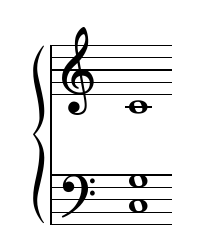
Who does not see that this paradigm does not contain a fourth, but a fifth and an eighth? For the intervals of the base [bass], and of the foundation [fundamental], are not also to be measured from the middle parts to the parts. For others have said that the major sixth is in the following example
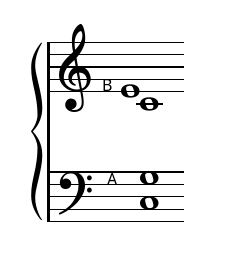
where note A with note B seems to make the sixth major. But who among mortals, even in art, will affirm that there is a sixth in this system, for the reason already adduced? But if they understand the fourth produced by arithmetical division in this manner:
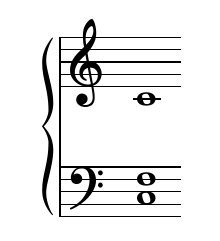
I do not know by what agreement they can relate it between the consonances; unless one wants to believe that, since ancient times, not only by speculation (because this interval comes from the immediate division of the Octave), but also by practice for consonance. Indeed, if it pleases anyone to reach out, I will not delay anything. True usage,
[p 26]
received from so many centuries, certainly seems to be opposed, to which we must conform; since its use has not been found to differ in the least from the use of the rest of the dissonances today, nor is there any reason to use it except by means of syncope or binding. It is indeed certain that the Fourth is less dissonant than the rest of the dissonances, and that it is also more tolerable to the ears, yet its perception does not completely satisfy the hearing. E.G.
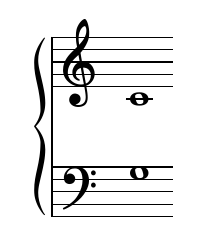
but it is clear that he still misses the fifth place below. E.G.

From what has been said thus far it becomes clear that the fourth and fifth are produced from the division of the Octave. Now we must see what intervals arise from the division of the fifth itself.
CHAPTER 18.
Of the division of the Fifth, or Diapentes.
From the division of the Fifth, or _Diapente_, two intervals are produced: "sesquiquarta" [1 + 1/4, or (4+1)/4]: 5:4. or ditone, & "sesquiquinta" [1 + 1/5, or (5+1)/5]: 6:5 or semi-ditone. By the harmonic division the ditone is placed in the lower part, and the semi-ditone in the higher part: the reverse happens by the arithmetical division.
From this it is clear that the Fifth consists of the major- and minor-3rds, which have their existence, as is evident, in the superparticular genus, and are consonances, but imperfect, either because their terms united by addition exceed the number of the 3rd, or because nature does not at all concur in their production.
The order would only request that we mention the fourth, or _Diatessaron_ division; and since this interval cannot be divided, because its divisor, or middle term, should be a number of seven: 8:7:6, which, being a mystical number, cannot be used in dividing accounts (so that the danger of taking it will become manifest), therefore to the division of the major third, or _ditone_ we must go forward.
[Note from Monzo: Fux's use of the word "danger" is interesting: this may be the origin of Danielou's idea that "7 is dangerous". As seen on p 24, Fux completely accepts Zarlino's 1558 dictum that the senario (1,2,3,4,5,6) is the basis of harmony.]
[p 27]
CHAPTER 19
On the division of the major-3rd, or Ditone.
From the division of the major-3rd 5:4 two intervals are produced: the "sesquioctave" [1 + 1/8, or (8+1)/8], or the major tone: 9:8, and the "sesquinone" [1 + 1/9, or (9+1)/9], or the minor tone, 10:9, which are dissonant intervals, in that they present an unpleasant sound to the ears, perhaps because their terms combined exceed twice the numbers of the senario; and consequently the strokes of such sounds are very difficult to unite.
And these are the intervals which are generated by division. The rest, such as the major-6th, or _Hexachordon majus_, the minor-6th, or _Haxachordon minor_, and all the intervals composed by addition, the major semitone, and the minor, and the comma are found by subtraction, as we shall see below. Let it be now
CHAPTER 20
On the formation of 6ths, major and minor
The major-6th is so called, because it occupies the sixth place in the diatonic genus; it is composed by the conjunction of a major-3rd and a minor-4th, in this way:
5:4
"+" 4:3
--------
20:12 [reduce:]
--------
5:3
From this it appears that it has its existence in the superpartite genus, namely: superbipartite thirds, and is the first species of this genus, and can also be formed in the manner stated above in Chapter 7, namely, taking the third number from the Pythagorean table for the minor, and leaving the quaternary, the quinary for the major term. e.g. 5:3., which proportion exhibits the major-6th. It can also be done by adding the ratio of one half to the other, in this way:
3:2 * 10:9 --------- = 30:18 /6 --------- 5:3
[p 28]
Although this interval has its place in the superpartite class, all the proportions of which produced dissonant intervals among the Pythagoreans, nevertheless, over time, 6ths counted among imperfect consonances and are still used as such in composition. This is about the major-6th.
The minor-6th, as stated above, is constructed from the constitutive terms of major-6th 5:3, adding the ternary to the quinary, whence is generated 8 for the greater term; let the major term of the major-6th be taken as the minor and this ratio will be 8:5, which is the form of the minor-6th itself.
By addition it is done in this way: let the ratio of the 6th be added, or the 4th to the ratio of the 6th or of a lesser 3rd, in this way:
4:3 * 6:5 --------- = 24:15 / 3 --------- = 8:5
which is the account of the minor-6th. Here it can be asked, when the 3rd and 6th major and minor consonances are imperfect, Which of them is to be considered more imperfect? For me, if we look at their constitutive terms, it is certain that the minor-3rd is more imperfect than its major because of that term 6:5 by addition to the unit, 11. they present: this truth, namely the 3rd 5:4, equally united they make 9. Let the judgment be the same concerning 6ths. It is true that in this matter there is not so much a consideration of terms as of genera, and the third have their existence in the superparticular genus, which is superior to the superpartite, to which the 6ths are subject, therefore these are to be held promiscuously more imperfect than the 3rds. This opinion is confirmed by the fact that the ears, deeply contented with the harmony issued by third parties, seem to desire nothing more.
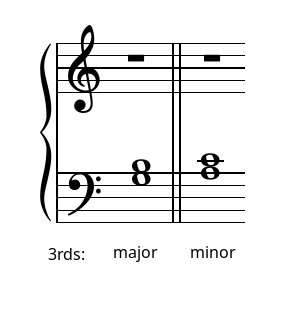 as: [B3-G3] 3rd major. [C4-A3] minor. not the same
as: [B3-G3] 3rd major. [C4-A3] minor. not the same
in sixths, the harmony of which, since it is not finished, that most certain judgment of the ears is not so much to prove
[p 29]
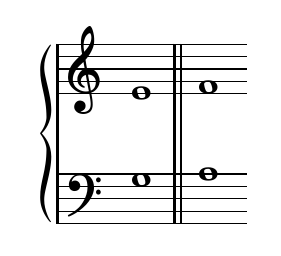 [G3-E4] [A3-F4] but still
major minor
[G3-E4] [A3-F4] but still
major minor
We try to find the octave below in this way:
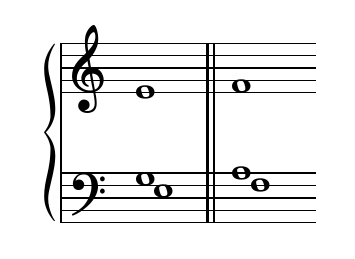 [G3-E4,E3] [A3-F4,F3]
[G3-E4,E3] [A3-F4,F3]
This chapter still remains. We must inquire about the 7th, or the major and minor heptachords, which are found in the same ratio by addition, by the following method: to the ratio of 1+1/2 or the 5th, 1+1/4 or the major-3rd is added in this way:
3:2 * 5:4 ------ = 15:8
And we have a ratio (7+8)/8, which is the form of a major seventh, of a dissonant interval: but in order to find the ratio of a minor seventh, add the ratio of (1+2)/2 and (1+5)/5:
3:2 * 6:5 ------ 18:10 ------ / 2 ------ = 9:5
and there arises a ratio (4+5)/5, constituting the ratio of the minor-7th, of the same dissonant interval.
The last thing that remains at this point is to inquire into the account of tritone and the false-5th, which two intervals are discordant. The ratio of the tritone is found by adding two (1+8)/8 tones to the (1+9)/9 tone, in this way:
9:8 * 9:8 * 10:9 -------- 810:576. / 18 -------- 45:32
[p 30]
This ratio is the over-parting of the 32, to form the tritone.
The false fifth is composed by the addition of a major semitone to the fourth.
4:3 * 16:15 ------- 64.45
This ratio is (45+19)/45.
Having already found all the intervals contained within an octave in the diatonic class, with the exception of the major and minor semitones and commas, since these things are to be sought not so much by addition as by subtraction, it seems that a new chapter must be established.
CHAPTER 21
On the formation of the Major, Minor, and Comma Semitones.
A semitone is the greater difference, or that interval by which a (3+1)/3 exceeds a (4+1)/4, which is found by subtracting one ratio from the other, in this way:
4.\/ 3. sesquitertia [(3+1)/3, or 1 + 1/3] 5./\ 4. sesquiquarta [(4+1)/4, or 1 + 1/4] --------------------- 16. 15. difference A semitone major.
This ratio (15+1)/15 constitutes a major semitone.
The minor-semitone is the difference found by subtraction between (4+1)/4 and (5+1)/5, e.g.,
5.\/ 4. "Sesquiquarta" [(4+1)/4, or 1 + 1/4] 6./\ 5. "Sesquiquinta" [(5+1)/5, or 1 + 1/5] ------- 25:24 "Sesquivigesima quarta" [(24+1)/24, or 1 + 1/24] The difference.
A comma is that difference by which a major tone surpasses a minor tone, as is evident by the subtraction of a "sesquinone" [(9+1)/9] from a "sesquioctave" [(8+1)/8]:
9:8 Major tone / 10:9 Minor tone. ------- 81:80 Comma.
[p 31]
These, then, are all the simple intervals which arise either directly or mediately from the Octave division made by Ptolemy (which, at the end of the controversy, is the best of all), and which, in the order in which they are produced, with their constitutive terms, and names, you may see in the following table:
Simple intervals.
8th (Octave): 2:1. Diapason, or double.
5th: 3:2. Diapente, or 1 + 1/2.
4th: 4:3. Diatesseron, or 1 + 1/3.
major-3rd: 5:4 Ditone, or 1 + 1/4.
minor third: 6:5 Semi-ditone, or 1 + 1/5.
major tone: 9:8 1 + 1/8.
minor tone: 10:9 1 + 1/9.
major-6th: 5:3 Large hexachord, or 1 + 2/3.
minor-6th: 8:5 Small hexachord, or 1 + 3/5.
major semitone. 16:15 1 + 1/15.
minor semitone: 25:24 1 + 1/24.
Comma: 81:80 1 + 1/80.
tritone: 45:32 1 + 13/32.
false-5th: 64:45 1 + 19/45.
[Monzo: lattice of the basic intervals given in Fux's description of "Intervalla simplicia"
as reckoned from 1:1; the major- and minor-7ths are included in parentheses because Fux
describes them in his text but does not include them in the table; Fux measures the
semitones, comma, and tritones as between two of the more basic intervals.]
10:9 ----- 5:3 ----- 5:4 ----(15:8)
min.tone maj.6th maj.3rd maj.7th
\ / \ / \ / \
\ / \ / \ / \
4:3 ----- 1:1 ----- 3:2 ----- 9:8
4th unity 5th maj.tone
\ / \ / \ /
\ / \ / \ /
8:5 ----- 6:5 ---- (9:5)
min.6th min.3rd min.7th
[Monzo: lattice of all intervals given in Fux's description of "Intervalla simplicia"
as reckoned from 1:1; Fux measures the semitones, comma, and tritones as between two
of the more basic intervals, but here they are seen from 1:1.]
25:24
/ \
/ \
10:9 ----- 5:3 ----- 5:4 -----15:8 -----45:32
/ \ / \ / \ / \ / \
/ \ / \ / \ / \ / \
[ ] ------ 4:3 ----- 1:1 ----- 3:2 ----- 9:8 ----- [ ]
/ \ / \ / \ / \ / \ / \
/ \ / \ / \ / \ / \ / \
64:45 -----16:15 ----- 8:5 ----- 6:5 ----- 9:5 ----- [ ] ----- 81:80
